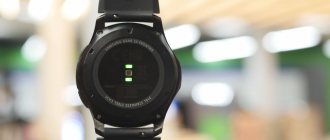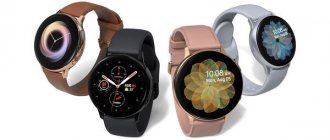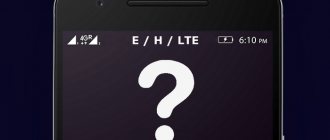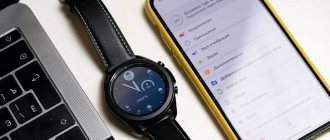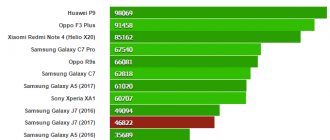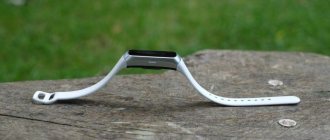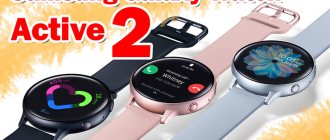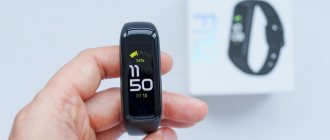Last year, Samsung quite unexpectedly entered the new smartwatch market with the Galaxy Gear model. The device, as expected, did not make big sales, although Samsung managed to report 800 thousand gadgets sold. However, the first attempt to create a smart watch was not in vain for the company. This year, Samsung plans to storm this market with two smartwatch models at once - Gear 2 and Gear 2 Neo. Let's see if the company was able to work out the bugs and what its new wearable gadgets are.
Samsung Gear 2 Neo (Charcoal Black) Smart watches and fitness bracelets on
Notify when on sale
Design and construction
The Gear 2 and Gear 2 Neo models have the same design and design, but the main difference between them is the body materials, as well as the presence of a built-in camera.
Gear 2 is the flagship of the line, so its front panel is covered not only by protective glass, as in the Gear 2 Neo, but also by a metal plate.
If we compare devices with Galaxy Gear, the company’s designers have improved not only the appearance, but also the design of smartwatches.
The new models have become smaller and lighter than their predecessors, while receiving a 22 mm rubber strap that can be easily changed independently.
There are no electronics in the strap, as there was in the Galaxy Gear, which greatly simplifies the repair of the device.
The strap is fastened well; even during sports, the likelihood of the watch falling off your hand is minimal. The mount also allows you to adjust the size of the bracelet.
Almost the entire front panel of the Gear 2/Neo is a 1.63-inch touchscreen display, which is used to control the watch. The only mechanical key is located under the screen and is responsible for turning it on/off, as well as locking. In addition, you can assign a quick launch of the application to double-clicking the button.
At the top of the Gear 2's display is a 2-megapixel camera window, as well as an infrared port.
The Gear 2 Neo does not have a camera, and only the IR blaster takes its place.
There is a microphone on the right side of the devices.
And on the left is an external speaker.
The base of the Gear 2/Neo case is made of matte plastic, while on the bottom of the watch there is a connector for the charger, as well as a heart rate monitor.
The metal on the front makes the Gear 2 look more solid than the Gear 2 Neo, but overall both devices are suitable for both casual and sporty styles. And if the Galaxy Gear looked exactly like a gadget, then the new models still look more like a watch.
Characteristics
If you were hoping for a complete redesign, then I have bad news for you. Aesthetically, Gear 2 is a continuation rather than a reimagining.
The case is made of brushed metal, and the strap is still the same plastic as before. In general, the design is still the same, even the lock remains unchanged. But small changes are still present.
For example, the microphone, as well as the camera, were moved from the clasp to the watch case. So now, the strap is a piece of ordinary plastic, without any microcircuits or high technologies inside. And this is great, because now you can easily replace it with another strap of your favorite color.
My review unit came with a brown strap, which, it should be noted, very nicely emphasized the design of the watch itself. Of course, I didn’t really want to change it, but the opportunity itself seemed like a very pleasant bonus to me. Another nice change is the lack of visible screws on the watch panels. Under the 1.63-inch Super AMOLED screen, as before, there is a single button.
I don't think anyone buys a smartwatch based on processor speed, but in case you're wondering, the Gear 2 has a 1GHz dual-core chip. There is also a 300mAh battery, and although everything is very similar to the original, the device feels better and more assembled.
In addition to a couple of external improvements, the device has several internal changes that significantly expand the capabilities of the watch. In particular, these are: an optical sensor for measuring heart rate, an infrared port, as well as an IP67 class - complete protection from dust and the ability to work under water for up to 30 minutes.
The rest remains unchanged: Bluetooth 4.0, 4GB of memory, microphone and accelerometer. However, we have almost gotten rid of the stupid and flimsy charger and now the watch can be charged with a standard micro-USB cable.
Display
Like the Galaxy Gear, the new Samsung smartwatch uses a 1.63-inch Super AMOLED touchscreen display with a resolution of 320x320 pixels, which at this diagonal produces an image of 278 dpi.
The screen has good viewing angles, doesn't look grainy, and has decent color reproduction with near-perfect blacks.
In the sun, the Gear 2/Neo screen practically does not fade, but glares, although it remains readable.
With all this, the display is touch-sensitive, made using capacitive technology, and through it the main control of the smartwatch is carried out.
There are no problems with the screen's response to touches.
Camera (Gear 2)
The Gear 2 has a 2-megapixel camera with autofocus, capable of recording video in 720p resolution at 30 frames per second. But the camera in Gear 2 still won’t let you feel like a spy; it can only record 15-second videos.
Compared to the quality of pictures taken by the Galaxy Gear smartwatch, there are no big changes in the Gear 2. The 2-megapixel BSI sensor shoots at the level of smartphones from 5 years ago. The resolution of the images can be 1920x1080 pixels, 1080x1080 pixels or 1280x960 pixels.
Overall, the Gear 2's camera is better suited to storing information that can be recorded, but it's quicker to just take a photo.
The Gear 2 Neo, as I already wrote, does not have a camera, but as you can see from the quality of pictures from the Gear 2, the model does not lose anything from this.
Camera
There is also a camera here. A two-megapixel monster that can shoot photos and videos in 720p resolution and, in general, nothing else.
To be honest, I couldn’t understand who would want to use this camera when you have a phone in your pocket with much better performance for shooting both video and photos.
But I must admit, I was wrong. Of course, it is not at all suitable for photographing children or landscapes, but for a quick snapshot of a document or a reminder to google this or that object, the camera is very suitable. Compared to the old version, I like the new lens placement much better, not to mention the fact that the strap is now free of electronics and can be easily replaced.
S Health and heart rate monitor
Samsung was the first smartwatch manufacturer to integrate a heart rate monitor into its models. This step comes in conjunction with the new vector of development of the S Health application, which in the eyes of Samsung should become a single center of information about the user’s health. Now we can see one of the first stages of this concept, and with the availability of new sensors for smartwatches, it will develop. Today, S Health, paired with Gear 2/Neo, can count the user’s steps (thanks to the built-in accelerometer), measure heart rate, and also record running, cycling and hiking. By and large, Samsung smartwatches have everything that the Gear Fit smart bracelet has.
The heart rate sensor in the Gear 2/Neo works using an LED and a photosensor; its measurements are not 100% accurate and are rather advisory in nature. This is especially pronounced during running, when with a heart rate of 170 beats per minute, the watch can show 155-160 beats per minute. As a rule, this can be solved by fixing the bracelet more tightly on the hand, but in this case, when wearing the device for a long time, discomfort appears.
One of the components of S Health, as well as Gear 2/Neo, is the slip tracker function. It is implemented in exactly the same way as in Gear Fit. Smart watches in conjunction with an application can track the duration and phases of the user’s sleep. But the collected data is not analyzed in any way by the application, and the watch itself does not have a “smart alarm clock”.
The S Health connection on your smartphone plus Gear 2/Neo allows you to count steps, and while jogging, show the distance traveled, average speed and continuously count your pulse. Thus, the sports bracelet component in the Gear 2/Neo is implemented at the Gear Fit level, while the watch has greater potential than a smart bracelet, because it supports the installation of third-party applications. But more on that below.
Usage
It’s worth saying right away that today you are quite limited in your capabilities. All that is available is: notifications, clocks, receiving calls and a couple of new functions, which I will discuss below.
First, the RSS reader Feedly , which is my favorite third-party app. As you probably remember, after Google Reader , Feedly quickly plugged this gap, and from that moment on, I use this application on my computer every day.
So for me, the idea that I could check my feeds on the go from my Gear 2 was very appealing. However, in real life, this application does not behave as I hoped.
I didn’t really like that for it to work you first need to install the app on your phone. There's nothing difficult about it, but it does add a certain sense of attachment to your phone that you want to escape from when using the Gear 2.
The app itself isn't perfect (which is disappointing considering the Feedly web app is designed so well). When you find something interesting, you have a choice: read the feed later (by sending it to your phone) or read it right now (again on your phone).
However, when you choose the second option, the app does not interact with your phone in any way until you unlock it and launch the smartphone app. This is a small oversight that seriously affects the pleasure of using this program.
Secondly, it’s worth taking a closer look at the new player that works independently of the phone. Now you can download your favorite music directly to your smartwatch and listen to it through Bluetooth headphones, without the need for a bulky phone in your pocket.
The 4GB of internal memory is more than enough for the longest morning run, and the fact that you no longer need your phone creates a feeling of freedom.
As for the battery, it has become better. Runtime was one of the most glaring negatives of the Galaxy Gear. And I don't know what Samsung did, but the 300mAh battery (315 in the Galaxy Gear) now lasts three times longer. This watch worked reliably for three days and this was with fairly frequent use. And while I would have liked a bit more battery life, it's still a great result and solves one of the main problems of the last generation of Gear.
As for the new apps from Samsung. In theory, the heart rate monitor and the Exercise (the pedometer remains the same as before).
And while I'm glad Samsung is trying to come up with something new, the apps themselves don't work particularly well.
The heart rate monitor, for example, is somewhere between “decent” and “annoying” (just like on the Galaxy S5 ). When everything works (the first time - not often), the watch behaves well and produces fairly accurate data, akin to that of some sports wristbands. But if you suddenly move your wrist or make a sound (yes, the Gear 2 asks you to be completely still and quiet), you'll have to start all over again.
The Exercise app is equally controversial. This program, in tandem with S Health, works well. However, I couldn't figure it out with the pedometer. The step counter itself works well (a little optimistic, compared to dedicated devices), the number of steps goes up, but when I sync the data with the phone (a notification is displayed that the data has been successfully loaded), the data simply does not appear in the S Health app!
The above text describes the Gear 2, and Samsung in general, very well.
Almost everything you want is present: a camera (more about it below), calls, step and heart rate counter, media player and notifications. However, almost all of these functions do not work as we would like, and there is a feeling that you are only using a demo version of the app.
I'd really like to see Samsung get more involved in the software issue, or at least have third party developers take it on. After all, Gear 2 has potential and it needs to be developed.
Platform, interface and applications
The Gear 2 and Gear 2 Neo smartwatches are built on a 1 GHz dual-core processor and are equipped with 512 MB of RAM and 4 GB of internal memory.
Unlike the Galaxy Gear model, which ran on the Android platform, the new smartwatch is based on Samsung's own Tizen design. It was precisely because of the use of a different platform that the company abandoned the Galaxy brand in the name of its new smartwatches. If we compare it with its predecessor, the change in platform has benefited the Gear 2/Neo. The logic of the interface in Samsung smartwatches has largely not changed, but it has become faster. In addition, the company's developers managed to better optimize Tizen for wearable gadgets in terms of autonomy. With a smaller battery, the device still works for the same 3-4 days.
The system interface consists of several screens with icons. The main screen is the time display. The user can customize it for himself by choosing one of the design themes and a skin for the watch.
The main menu consists of four application icons, while in the settings you can switch to displaying one icon on the entire screen.
The menu has two levels, the first contains the main applications, and the rest are hidden in the second level in the “Programs” folder. From it, applications can also be moved to the main menu. In addition, menu screens can be swapped or deleted along with applications using the same logic that widget screens work in Android.
Since Tizen is an open platform, developers can create applications for the Gear 2/Neo. This is by far the biggest drawback of Samsung's OS compared to Android, as even the Galaxy Gear had more software available than what is currently available on the Gear 2/Neo. However, the company promises that this problem will be resolved over time.
But now it's really difficult to find useful apps in the Samsung Apps store. Installation and work with programs is carried out through the Gear Manager utility on the smartphone.
Smartwatch Samsung Gear 2
High-quality work on bugs
Last September, Samsung introduced the first generation of its smartwatches, called Galaxy Gear. The product attracted increased attention from the press and gadget lovers, but after getting to know it closely, many (including us) were disappointed. However, the company did not stand still and just six months later announced a new generation of watches: Gear 2 and Gear 2 Neo.
This event took place at the end of February at the Mobile World Congress in Barcelona. And two months later, the gadget went on sale (including in Russia).
The Gear 2 watch entered the market simultaneously with other new Samsung products: the Galaxy S5 smartphone, the Gear Fit smart bracelet and a cheaper version of the watch - Gear 2 Neo (its difference is the absence of a camera, a partially plastic case, slightly less weight and a cost of 3,000 rubles lower) . In this article we will consider the top-end option - Samsung Gear 2, but we will definitely compare it with the above-mentioned devices from the field of wearable electronics, and with competitors.
Let's look at the specifications of the new product.
Specifications Samsung Gear 2
- CPU @1 GHz (2 cores)
- Touch display 1.63″ Super AMOLED, 320×320, 278 ppi
- Random access memory (RAM) 512 MB, internal memory 4 GB
- Bluetooth 4.0LE
- Two microphones, 1 speaker
- Gyroscope, accelerometer, heart rate sensor
- 2.0 MP camera, back-illuminated BSI sensor
- Li-ion battery 300 mAh
- Tizen operating system
- Compatible with Samsung devices running Android 4.3 and later
- Compliant with IP67 protection standard
- Dimensions 37x58x10 mm
- Weight 66 g (measured by us)
For clarity, we decided to make a table with the characteristics of other smartwatches (including the first version of Gear), adding into it those parameters that are currently key when choosing a device of this type.
| Samsung Gear 2 | Samsung Galaxy Gear | Sony SmartWatch 2 | Pebble Steel | |
| Screen | touch, color, Super AMOLED, 1.63″, 320×320 (278 ppi) | touch, color, Super AMOLED, 1.63″, 320×320 (278 ppi) | touch, color, 1.6″, 220×176 (176 ppi) | non-touch, black and white, E-Paper, 1.26″, 144×168 (176 ppi) |
| Protection | yes (IP67) | yes (IP55) | yes (IP57) | yes (IPx7) |
| Strap | removable | non-removable | removable | removable |
| Camera | yes (2 MP) | yes (1.9 MP) | No | No |
| Microphone, speaker | There is | There is | No | No |
| Compatibility | Samsung devices running Android 4.3 or higher | Samsung devices running Android 4.3 or higher | Devices running Android 4.0 or higher | iOS and Android devices |
| Third party app support | There is | There is | There is | There is |
| Battery capacity (mAh) | 300 | 315 | 110 | 140 |
| Dimensions* (mm) | 37×58×10 | 37×57×11,1 | 42×41×9 | 46×34×10,5 |
| Weight (g) | 66 | 74 | 46 | 56 |
*according to manufacturer information
From the table you might get the impression that the difference between the new Gear 2 watch and the previous version is not so great. But in fact, Samsung has improved (more or less significantly) many parameters that were not included in the table. As for comparison with competitors, here it is worth paying attention, first of all, to the higher pixel density of the Samsung watch screen, as well as the presence of protection according to the IP67 standard (competing products have a lower protection class). And of course, don’t forget about the presence of a camera, microphone and speaker.
At the same time, Samsung Gear 2 has more weight than its competitors, and in addition, the price is significantly higher. The official price of the gadget at the time of sales start is 12,990 rubles. However, the first version of the Galaxy Gear was sold for 14,990 rubles (now its price has been reduced to 11,990 rubles).
Let's get started with the Gear 2, but first we ask you to refresh your memory of the articles about the Galaxy Gear and Gear Fit, since in the story about the Gear 2 we will repeatedly refer to these materials.
Equipment
The watch arrived to us without a box, so there will be no detailed story about packaging and accessories. But we will still tell you about one element of the kit, without which the watch cannot operate. This is the charging dock attachment.
It is connected to the watch from the inside - so that the contacts on the attachment coincide with the contacts on the watch. The nozzle locks tightly with a slight click.
On the right side of the nozzle there is a Micro-USB connector, to which the charger is connected (any charger for a smartphone will do). Note that in the first version of the Gear watch, the charging unit was designed in the form of an additional plastic case that was put on the watch. This solution is much less convenient.
The new attachment is very similar to that of the Samsung Gear Fit.
Design
Let's say right away: Samsung designers and engineers did a great job. The design of the Gear 2 is much better than the first version, and perhaps the best available on the market, but the continuity with the first version of the Galaxy Gear remains.
This is a vivid example of high-quality work on bugs: they improved it a little here, they changed it a little there - but in the end we got a much more pleasant and convenient product. Let's list the main changes.
First, there is a Home button. It is made of metal, has a beautiful texture and is located under the screen, on the metal area separating the screen and the strap. At the same time, Samsung has removed the screws that were noticeable on the Galaxy Gear from this area.
Secondly, the watch has become thinner. Moreover, the case itself is now less massive (this can be clearly seen from the photo above), and the strap has become more elegant. As for the strap, it is now removable - and this is the third significant point.
In order to make it possible to detach the strap, the company's engineers had to move the camera from the strap to the watch case. Now it is located on top of the screen (symmetrically to the Home button). And this is another important aspect. In addition, the camera eye no longer protrudes as it did before, but looks quite elegant.
Another design difference between the Gear 2 and the Galaxy Gear is the addition of a new sensor: a heart rate monitor located on the back of the watch under the contacts. It works the same way as in Samsung Gear Fit.
The last thing that needs to be mentioned when describing the design of the Gear 2 is the placement of microphones and speakers. The speakers are located on the left side, closer to the inner surface of the case, in contact with the hand. The microphone hole is on the right side (in the photo below there is a small hole on the left side of the photo on the edge).
The watch's silicone strap has the same type of clasp as the Galaxy Gear. The strap material itself (dense silicone) is quite pleasant to the touch. Its inner surface, in contact with the hand, is ribbed, and the outer surface has fine corrugation.
Overall, the design of the watch is beautiful and functional. Gear 2 looks quite stylish and versatile: they are suitable for both men and women; both the student and the serious businessman. Of course, there is no such wow effect as in the case of the Samsung Gear Fit, so I would consider the Gear Fit to be the main alternative to the Gear 2. On the other hand, if you want a gadget that looks exactly like a watch and not like a bracelet, then the Gear 2 seems to be the best option.
Screen
The Samsung Gear 2 display has the same characteristics as the first version of the Galaxy Gear watch: Super AMOLED, 1.63″, 320×320. Has the screen undergone any changes? This question will be answered by detailed testing carried out by the editor of the “Projectors and TV” section, Alexey Kudryavtsev.
The front surface of the screen is made of mineral glass with a mirror-smooth surface that is scratch-resistant. Judging by the reflection of objects, there is a very effective anti-glare filter that is superior in reducing reflection brightness to the screen filter of the Google Nexus 7, which we use in our tests as a reference sample.
The doubling of reflected objects is very weak, indicating that there is no air gap between the layers of the screen. There is a special oleophobic (grease-repellent) coating on the outer surface (effective, no worse than that of Google Nexus 7), so fingerprints are removed much easier and appear at a lower speed than in the case of regular glass.
When displaying a white field in full screen, the maximum brightness value was about 325 cd/m² (conventional value 6, or “outdoor” mode), the minimum was 5 cd/m². Given the high efficiency of the anti-glare filter, on a sunny day outdoors, screen readability will remain at a high level, and in complete darkness, the brightness can be reduced to a comfortable value. Standard brightness (conditional value 4) is 150 cd/m², which is enough for a well-lit room. This screen uses a Super AMOLED matrix - an active matrix on organic light-emitting diodes. A full-color image is created using subpixels of three colors - red (R), green (G) and blue (B) in equal numbers, as confirmed by a fragment of a microphotograph:
We observed a similar “structure” of the screen, for example, in the case of the Samsung Galaxy Gear. The screen is characterized by excellent viewing angles - colors and brightness change very little even with large deviations of the view from perpendicular to the screen. Black is just black from any angle. It is so black that the contrast setting is simply not applicable in this case. However, around the reflection of bright objects there is a bluish halo, which is more extended along the arm. This halo in the light somewhat reduces the apparent blackness of the screen. The uniformity of the white field is excellent.
In general, the screen, apparently, remained the same as on the Galaxy Gear, without undergoing major changes (we are more likely to attribute the slightly decreased brightness to changed software settings).
At the moment, the Samsung Gear 2 screen is practically unrivaled. Practically - because, on the one hand, we should not forget about the Pebble screen, which has completely different qualities, and on the other hand, it cannot be said that the Gear 2 screen is better than that of the Gear Fit. But again, Gear Fit has completely incomparable properties, and they cannot be compared directly.
Pairing with a smartphone
Like the Samsung Gear Fit, the Gear 2 smartwatch only works with Samsung smartphones, and only those running Android 4.3 or later. To get started, you need to install the Gear Manager application from the Samsung Apps catalog.
We connected our smartphone (Samsung Galaxy S5) to the watch without any problems. As for the application itself, its functionality is generally similar to the Gear Fit Manager application, which we talked about in the article about Samsung Gear Fit. The difference is due to differences in the functionality of these two devices and is contained in three main menu items: “My Applications”, “Samsung Apps” and “Find My Gear”.
Find My Gear sends a signal to the watch, causing it to make a sound (the Gear Fit doesn't have a speaker, so it can't make a sound). My Apps is a list of installed apps, and some of them have additional settings. But the most interesting thing is “Samsung Apps”. This is a directory of applications for the Gear 2, written primarily by third-party developers.
The apps are sorted into seven categories. At the moment, the total number of applications exceeds one hundred. Installing them on the watch is simple: select the desired application, click on the button with the price (if the application is paid) or the word “free”. Once the download is complete, the app will already be on your watch (Applications section), as well as in the My Apps menu in Gear Manager. You can only delete an installed application via your smartphone. However, this is done very simply and intuitively.
Samsung Gear 2 functionality
At the moment, of the smartwatches on the market that are not a stand-alone device (like the Iconbit Callisto 100), Samsung Gear 2 has the widest functionality. With Gear 2, you can answer a call without taking your smartphone out of your pocket or using an additional headset, take a photo, measure your pulse, count your steps... In general, there are really considerable possibilities. They overlap some of the functionality of the Gear Fit, but the Gear 2 is a more versatile device.
The Gear 2 watch runs on a new operating system - Tizen. Let us remember that this is the brainchild of Samsung and Intel, based on the Linux kernel and working with HTML5 applications. Tizen traces its pedigree to the MeeGo operating system, which, in turn, is rooted in Maemo (the history of these projects can be read here and here). At Mobile World Congress 2014 we saw a large Tizen stand, where engineering samples of smartphones running this OS were presented, and in recent months there have been persistent rumors that Samsung is about to release a commercial sample of a smartphone with Tizen. However, rumors are rumors, but this OS has already found application in watches.
What does this mean for the average user? It doesn't mean anything. Externally, the Gear 2 interface is something between a Galaxy Gear and a Gear Fit (neither uses Tizen). Moving icons here occurs in the same way as in regular Android, installing and uninstalling applications - only through a smartphone, working with files - again only through a smartphone, not counting the ability to transfer photos, videos and audio notes via USB to a computer. In short, if you don't know that the Gear 2 runs on Tizen, there's no way you'll feel it. If you know, this knowledge will not give you any advantages.
Let's take a look at the watch interface and the set of pre-installed applications.
The start screen is the clock itself. Initially, many types of clocks are available in the device, as well as in the Samsung Apps application catalog, so the start screen and the presence of certain elements on it (weather, calendar notifications, etc.) can be customized.
Like the Gear Fit, the screen turns on when we make a gesture with our hand towards ourselves (because of this, it often happens that the watch turns on in vain - for example, when you zip up a jacket or get dressed). To go to the next screen, you need to swipe to the left. You can always return to the start screen by pressing the physical button. Press the button again and the watch display will turn off. So, on the second screen we see “Notifications”, “Logs”, “Dialing” and “Contacts”.
Everything is clear here. Of course, dialing a number on a tiny screen is not very convenient, but overall the interface is good and quite intuitive. Although there is still room for improvement. Firstly, USSD commands from the watch are not supported. Secondly, you cannot delete a letter on your phone (it is only deleted from your watch). Thirdly, contacts are displayed only in the order of first name and last name, and the last name almost never fits in. Therefore, the list looks like this: Alexander B.., Alexandra .., Alexander I..., Alexander... It’s possible to guess who is who, but it’s not very convenient. These are perhaps the main disadvantages. Another feature (it may or may not be considered a disadvantage) is the fact that notifications arrive in a “closed” form. That is, you see who the letter or message on social networks came from, but you have to click on it to open the text. This is unlike Pebble, where notifications can be read immediately.
Go ahead. The next screen contains icons for “Applications”, “Camera”, “Settings” and “Management”. The set of settings in the Options menu is almost exactly the same as the Gear Fit. “Controls” basically duplicates the options available in “Settings” - it’s just a quick way to adjust screen brightness and sound volume. "Applications" is a list of all installed applications.
The next screen contains “Deleted. WatchON", "S Voice", "Music" and "Voice Memo". The first is the ability to use the watch as a TV remote control. A dubious possibility, since it’s hard for me to imagine a person who would sit at home wearing a watch, but without a smartphone at hand. However, as they say, so be it. S Voice - voice control. In principle, a really working thing, including understanding Russian-speaking contacts, for example (you can say “Call Anton” - and the application will start calling a contact named Anton, if there is only one). But for now it is too thoughtful and unstable, so it’s faster and easier to do the same thing the traditional way.
“Music” is one of the most interesting features. If with the help of Gear Fit you can only control music playback on your smartphone (Gear 2 also has this function, but the application is called “Media Remote”), then we can use the watch as an independent MP3 player. Tracks can be loaded into the watch's memory via a computer or transferred from a smartphone via Gear Manager - and then you can listen to music using the watch without the participation of a smartphone. True, you will need a wireless headset (unless, of course, you seriously consider the built-in speaker of the watch).
The last screen of the main menu includes icons for Pedometer, Workout, Heart Rate, and Sleep. We talked about the functionality of the first three applications in the Gear Fit review - there are no changes here. As for the “Sleep” application, it should record the phases of your sleep, but, let’s face it, sleeping with a watch is both inconvenient (they still get in the way a lot, compared to the same bracelet), and I’m afraid for their safety (suddenly somehow unsuccessfully, will you press down the screen or throw your hand away?).
In addition to the above, the “Applications” menu has “Find Device”, “Gallery” (viewing photos from the Gear 2 memory), “Media Remote” (controlling music on your smartphone), “Weather”, “Schedule” (synchronizes with the calendar; source calendar can be specified in Gear Manager), “Timer”, “Stopwatch”, “Email” and “Messages” (here the functionality is similar to Gear Fit). New applications are installed here, but any application (both pre-installed and new) can be moved from the “Applications” menu to the main menu.
PC connection
The watch can be connected to a PC to transcribe voice notes, photos and videos from the camera, and also to record music on the watch. Windows treats the Gear 2 as a removable drive with a capacity of 2.81 GB, of which 2.64 GB are free (apparently 170 MB are hidden system files).
When you first connect, Windows takes a long time to search and download drivers from the Update Center, but in the end everything goes smoothly.
While connected to a computer, the watch battery is recharged.
Camera
The only camera on the watch is located in the metal area above the screen. To take an even shot of what you see in front of you, you need to position your hand as if you were a schoolboy sitting at a desk - that is, parallel to the floor.
By default, the camera shoots with an aspect ratio of 1:1, pictures are taken with a resolution of 1080x1080. To obtain maximum resolution images, you need to set the camera settings to 16:9 mode. Then the pictures will be taken with a resolution of 1920×1080.
Examples of test shots are shown below. Note that the first 5 frames were taken in autofocus mode, and the last one (with the flower) was taken in macro mode. Comments on the pictures and video were prepared by the author of the “Digital Photo” section, Anton Soloviev.
Based on these images, we can say that a miracle did not happen again, and Samsung has not yet managed to endow the tiny module with decent quality. In any case, the camera is no better than the Samsung Galaxy Gear. The large grain from the noise reduction is still noticeable, and even noise appears in places. The sharpness of the images leaves much to be desired. The main reason for these problems is the low resolution. And, of course, weak optics. These are all significant shortcomings of the camera. Color rendering and exposure work cannot be praised either.
We can only conclude that the camera is still completely unsuitable for any practical tasks, and its pictures can only be viewed on a smartphone screen without frustration.
The camera can shoot video at 720p resolution. An example of the video is shown below.
| Video | Sound | |
| Video 1 | 1280×720, 30 fps, AVC MPEG-4 [email protected] , 12 Mbit/s | AAC LC, 277 Kbps, stereo |
Video, unlike photos, is done very well by the camera. Even still images look quite clear, sharpness is acceptable, and there are no noticeable problems with wiring. Perhaps the manufacturer did the right thing by limiting it to 720p, since in this case, most likely, video in Full HD resolution would have looked much worse.
On the other hand, the resolution of video recording suggests interpolation of photographs, which can also be indicated by a certain “soapiness” of thin lines in the photo. If our assumption is correct, then 1 megapixel pictures would look better. However, then they would be completely useless.
Autonomous operation
The first version of the Galaxy Gear with battery life didn't fare well: with heavy use, the battery could be drained within a day. Gear 2 made a big step forward in this regard: with average intensity of use, the watch will last three or four days, and if you use it actively (but without the conscious goal of draining the battery), then less, but you can safely count on two days.
Unfortunately, we do not yet have a methodology that allows us to objectively compare the battery life of different smartwatches, since, firstly, the functionality of these devices is completely different (for example, somewhere there is a camera, and somewhere not; somewhere there is autonomous playing music, but sometimes not), and secondly, they do not imply any prolonged continuous use, for example, for reading, web surfing or games. Therefore, the only way to somehow measure battery life is to simply use the watch in real life for a while.
I wore the Samsung Gear 2 for four days. Before this they were fully charged, by the end of the fourth day they were discharged. While using it, I spent a lot of time studying the interface, looking at some notifications, and answering several calls. The camera was not used at all (the photographs shown in the article were taken earlier). Fitness functions too (except that I measured my pulse several times). In general, we can say that this is a medium-intensity use, determined by the real needs of the user and the features of the device (for example, why use a mediocre watch camera if you can use a great smartphone camera?). And with such use, Gear 2 is in no way inferior to the same Sony SmartWatch 2 and may well compete even with Pebble (if, again, you use the watch in the same way, that is, you do not use features that are not available with Pebble). Worthy result!
conclusions
We are now witnessing a very interesting period: before our eyes, a new market is rapidly forming - smart watches. If just six months ago the devices available for sale resembled, rather, experimental engineering samples, now not only technologists, but also ordinary users have plenty to choose from. Moreover, if earlier there was a choice according to the principle “fish for lack of fish and cancer”, now, on the contrary, several devices may be attractive at once.
For example, Samsung Gear 2 is certainly attractive because it allows you to make calls and answer incoming calls without taking out your smartphone, use voice control (well, until you get enough of it), and also listen to music without a smartphone at all. In turn, the Gear Fit device impresses with its curved screen of an unusual shape and convenience. Among the competitors, Pebble Steel stands out, but there are much tougher rivals ahead: LG and Motorola watches on Android Wear, as well as the long-awaited Apple iWatch. One way or another, if you, living in Russia, have decided to get a smart watch right now, and at the same time you own a relatively new Samsung smartphone (or are ready to buy one), we can safely recommend the Gear 2, as well as the Gear 2 Neo or Gear Fit ( The choice here, by the way, is not easy). Actually, the main obstacle here is precisely the connection to the Korean manufacturer. Another limiting factor is price. Still, for a toy (which is what smartwatches are so far), Gear 2 is a little expensive. But the price for Gear 2 Neo and Gear Fit is much more acceptable. We'd recommend the Gear Fit if it weren't for this quirky device's lack of third-party app support. Therefore, based on the combination of qualities, the Gear 2 Neo seems to us the most attractive option (the camera, in general, is an extra thing for a watch - at least at this level of implementation). Perhaps, in terms of price and functionality (coupled with ease of use), this is the best offer on the market today.
But you need to be prepared for the fact that within six months your gadget will become obsolete. And it is possible that Android Wear devices and the Apple iWatch will have killer features that will immediately reduce the attractiveness of the current Samsung line. However, we repeat, this will happen only in a few months, and it is not a fact that these new devices will be as balanced and successful as the Samsung Gear 2 / Gear 2 Neo. And we have no doubt that the new Samsung watches are truly successful.
Good design (yes, this watch is not a shame to wear in any society!), convenient and pleasant software, wide functionality, stable operation (we did not notice any freezes, crashes, or slowdowns, except for the slow operation of S Voice), excellent screen - all these are undoubted advantages. Of course, there are minor shortcomings (for example, the camera is still far from perfect). Well, the connection to Samsung devices (and only on Android 4.3/4.4) is upsetting. But such is the market strategy of the Korean manufacturer: apparently, they still consider watches more as an additional incentive for buying a smartphone, rather than as an independent market.
In conclusion, we invite you to watch our video review of the Samsung Gear 2 smartwatch:
Samsung doesn't often receive the Original Design award from us, but in this case we believe that the Korean manufacturer fully deserved it.
Working with Galaxy smartphones
Like all Samsung wrist gadgets, Gear 2/Neo can only work with the company’s smartphones and tablets. At the moment, devices can be connected to the following models: Galaxy S5 / Grand 2 / Note 3 / Note 3 Neo / Note 2 / S4 / S3 / S4 Zoom / S4 Active / S4 mini / Mega 6.3 / Galaxy Mega 5.8 / Note 10.1 (2014 Edition) / NotePRO (12.2) / TabPRO (12.2/10.1/8.4).
To work with a smartwatch, you must install the Gear Manager application on your smartphone or tablet.
Device communication is ensured by the Bluetooth 4.0 module. There are no problems with the connection.
Software
The first thing you'll need to do when you take the Gear 2 out of the box is connect it to one of the 17 supported devices. Any high-end Samsung device should work.
Now that you've paired the two devices via Bluetooth, it's time to download the Gear Manager app from the Samsung store and start using your new smartwatch.
It is worth noting that in the first few days you will very often resort to using this app, because through it you will be given the opportunity to change the appearance of the interface and other settings related to the operation of the watch. Of course, the Gear 2 itself has these settings too, but changing them is much easier and faster from the screen of your device with a larger screen.
As for Gear Manager, everything remains unchanged. Samsung, in turn, compensates for this by the fact that the watch itself has moved away from Android and now uses its own OS - Tizen . But what does this mean besides the absence of the Galaxy ?
First of all, all applications from the first version of Gear are a thing of the past and do not work on the new Gear 2. This is quite serious because users may have already gotten used to them, and as we all know, people hate change.
Plus, we remember how bad things were with third-party Gear apps. In the months since the watch's release, things have moved forward and we've seen some really interesting apps, but with the introduction of Tizen, all the progress has evaporated and we're back to square one.
For those who are interested in what has actually changed in the system itself, the answer is: practically nothing. The interface remains exactly the same: font, icons, menus - everything is identical. Everything, as before, looks very clumsy and casual. But I must say that the interface does not suffer from anything unnecessary, and the functions are very easy to use.
The only area in which the new OS has improved is the number of standard applications. While you wait for Facebook and Twitter to release their own apps for the Gear 2, Samsung has provided plenty of native apps that should justify buying the watch so early in its life.
The list of these applications includes both familiar ones: pedometer, stopwatch, dialer, media controller and access to calls, as well as new items like: Exercise , heart rate counter and built-in media player, which uses the internal memory of the watch, not the smartphone. Most of the new apps are clear from their names, and Exercise is a watered-down version S Health .
However, it is worth noting that the device is well supported, and in two days I installed several updates that were not limited to simple bugfixes. One of the updates included a sleep tracking app.
And while the app itself is fairly straightforward (you just tell the app when you go to bed and when you get up), it's nice to know that Samsung isn't leaving the Gear 2 behind and is trying to make it a better gadget.
Another area where the Gear 2 improves over its predecessor is notifications. For many, the whole point of such a device was to receive notifications from applications and calls on the watch.
The first version of Gear wasn't very good in this regard. For example, when an email arrived, the Galaxy Gear simply displayed a notification: “You have mail.” Thank you so much, Gear! With Gear 2 the situation is better, and a fairly large amount of text from the letter itself is now displayed next to the notification.
Plus, notifications on the new version of the watch support a huge number of applications, so if you need it, now you won't miss a single notification from Candy Crush.
Alerts
One of the important components of working with the Gear 2/Neo is notifications from your smartphone. Compared to the Galaxy Gear, the developers have done a lot of work on bugs. Let me remind you that the first Samsung smartwatch also included the ability to view notifications, but in a number of applications the watch only showed the fact of an incoming letter or message; it was impossible to read them. In Gear 2/Neo this problem is solved; you can read a message or the beginning of a letter right on the watch display, this is enough to understand whether it is worth picking up the smartphone.
By the way, Gear 2/Neo works very smartly with Galaxy devices. If the smartphone/tablet is in your hands with the screen turned on, notifications will not be sent to the watch. Moreover, if a message is displayed on the Gear 2/Neo display and you lift the smartphone, it will immediately appear on its screen. Overall, with a Samsung smartwatch, the user can flexibly set up alerts and quickly filter them.
The developers managed to implement one of the best mechanisms for working with alerts on the market. Unfortunately, all this only works on Galaxy smartphones and tablets.
S Voice and voice calls
The Gear 2 and Gear 2 Neo have a built-in microphone and external speaker, allowing you to use your smartwatch as a headset. During an incoming call, the user can accept or reject it directly from the watch.
At the same time, you can also make calls with Gear 2/Neo; the gadgets have separate applications with dialing, call log and phone book.
In a noisy place, calling using a smartwatch is not very convenient; the interlocutor will be hard to hear, but in a car or on the street while jogging.
The S Voice voice assistant, well known to Galaxy smartphone users, has found its place in the Gear 2/Neo. With it, you can perform a number of tasks by entering commands with your voice, for example, make a call, send a message, create a task, check the weather forecast and much more.
S Voice works quite slowly on Samsung smartwatches, because, in fact, it processes the command not even on the smartphone, but on the Samsung server. As a result, the speed of its operation greatly depends not only on the performance of the devices, the quality of the Bluetooth connection, but also on the speed of the Internet.
Rivals
First of all, it is worth noting Pebble Steel ($250). And although Pebble does not have a color screen and camera, many still prefer this smartwatch. A large selection of apps and a long operating time play a significant role here.
You can also consider Qualcomm Toq ($250) and Sony SmartWatch 2 ($300). Both have their advantages, and it all depends on which manufacturer you like best, because their functions are very similar.
Remote control and multimedia
Quite unexpectedly for such a category as smart watches, Samsung decided to build into the Gear 2 and Gear 2 Neo an infrared port and an application for controlling TVs, media players and other compatible electronics.
It works quite well, and most importantly, controlling home appliances from the watch turned out to be really convenient.
The multimedia capabilities of the Gear 2/Neo include a built-in music player, as well as an application for controlling music playback from a smartphone.
And if the latter function is convenient to use, then a built-in media player in a watch with 4 GB of memory and the ability to connect only wireless headphones is clearly superfluous.
Autonomy and charging
The built-in battery in the Gear 2 and Gear 2 Neo has a capacity of 300 mAh, which is slightly less than the Galaxy Gear's 315 mAh. However, the autonomy of the new Samsung smartwatches has not decreased and lasts 3-4 days depending on the load.
This is not an outstanding result, but users are unlikely to feel much discomfort from charging gadgets once a week.
Eventually
Samsung's progress in developing smartwatches with the release of the Gear 2 and Gear 2 Neo models is visible to the naked eye. The company has indeed improved a lot, but it still needs to refine a number of features. Already, Samsung smartwatches can work well with notifications, but they clearly lack greater openness, namely the ability to work with Android devices other than Galaxy. This step will attract the interest of more third-party developers, and therefore promote the Tizen platform for wrist gadgets.
